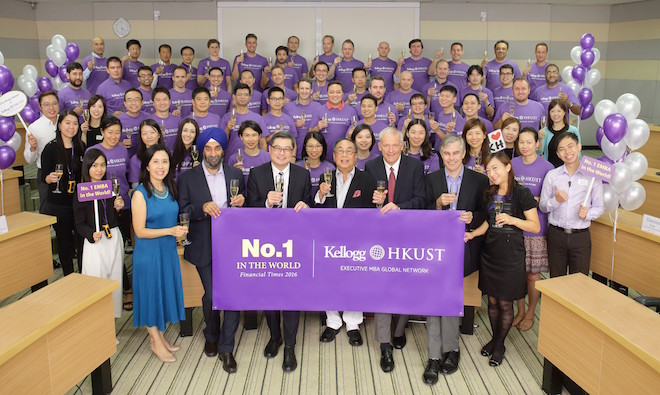
The joint EMBA program between Northwestern’s Kellogg School of Management and Hong Kong University of Science & Technology tops the 2017 FT list
Once again and for the eighth time, Northwestern University’s joint Executive MBA program with Hong Kong University of Science and Technology came out on top of the 2017 Financial Times ranking of the world’s best EMBA options.
The Kellogg/HKUST offering has consistently done well in this ranking, largely because the largest single factor weighted at 40% is compensation and alumni of the program have the largest average adjusted salary at $478,000. nearly $114,000 more than the alums who placed second in the pay category at Shanghai Jiao Tong University. The Kellogg partnership also boasts one of the highest satisfaction levels among alumni surveyed by the FT with 82% of alums saying they achieved their aims in getting the degree. Only five other schools did better.
The top seven programs on the FT list are all joint programs among two or more schools. In fact, second place honors went to EMBA-Global Asia, a partnership among Columbia Business School, London Business School and the University of Hong Kong. Yet, this was the first year that program was submitted to the Financial Times for ranking consideration.
WHY JOINT PROGRAMS TEND TO DOMINANT IN THE FINANCIAL TIMES RANKING
Rounding out the top five this year were No. 3 Tsinghua University with INSEAD, No. 4 EMBA-Global, delivered by Columbia and London Business School, and No. 5 Trium, a program put together by a trio of schools: HEC Paris, the London School of Economics and New York University’s Stern School of Business. No. 6 was Shanghai Jiao Tong University in China and No. 7 was Washington University’s program with Sudan University, also in China.
The dominance of partnership programs–which are often harder to insure quality due to multiple schools having to deliver the experience–is something of a quirk due to the Financial Times’ methodology. With compensation receiving the heaviest emphasis, the methodology favors schools with older and more experienced alumni who obviously earn more money. And because the FT adjusts pay by using purchasing power parity (PPP) rates, the distortions in such a calculation favor certain countries, especially China, where five of the FT’s top seven programs have anchors. Chinese business schools are also common partners with U.S. and European schools.
Think of it this way: China produced $10.98 trillion in goods and services in 2015.The U.S. produced $17.95 trillion. Apply the PPP calculation, however, and China’s GDP balloons to $19.39 trillion, ahead of the European Union and the United States. Without purchasing power parity, China’s GDP per capita would only be around $6,475, lower than the standard of living in Ukraine, Algeria or Kosovo. No wonder, six of the seven programs with the highest average alumni salaries are in China. Meantime, when it comes to the satisfaction level of alums, five of the six programs are outside China.
OXFORD, ESCP EUROPE, MIT SLOAN, AND IESE TOP SOLO EMBA PROGRAMS
The top five executive MBA programs put on by single schools this year were No. 8 INSEAD, No. 9 Oxford Said, No. 10 ESCP Europe, No. 11 MIT Sloan, and No. 12 IESE Business School in Spain. The U.S. solo EMBA programs generally considered to be among the best in the world didn’t fare all that well in the FT methodology. Wharton and Chicago Booth ended up in a tie at 15th place. Duke’s EMBA program finished 21st, while Kellogg’s solo program placed 26th. Even more surprising, Columbia Business School’s EMBA in New York ranked 40th, down a dozen places from its 28th place finish a year ago.
Michigan Ross’ EMBA was ranked 36th, NYU Stern’s solo offering placed 33rd, up five spots from 38th last year, and UCLA’s Anderson School was ranked 48th, a tick better than last year’s rank of 49th. UC-Berkeley’s Haas School wasn’t on the list at all because the school declined to participate in the voluntary ranking.
Those less-than-stellar showings are also a function of methodology because the FT approach tends to favor European and Asian programs, with an 18% weight on a series of “international” metrics centered on faculty, students, board members and course offerings outside a home country. Those metrics place U.S. programs at a distinct disadvantage and help to encourage more European and Asian advertising in the Financial Times.
THIS YEAR’S RANKING WINNERS & LOSERS
Among this year’s big winners and losers in the ranking is the joint program between UCLA’s Anderson School of Management and the National University of Singapore. That program plunged 16 places to 22nd place from sixth last year, the largest drop of any program in the Top 25. INSEAD’s executive MBA program fell four places to rank eighth this year. IE Business School dropped three spots to place 13th.
And the winners? Obviously, ranking second in your debut on the FT list qualities as a big victory for EMBA-Global Asia, the Columbia, London and Hong Kong joint program. But the biggest gainer in the Top 25 this year was No. 24 Singapore Management University which jumped eight places from 32nd a year earlier. The EMBA Global program, delivered by Columbia and London Business School, rose four spots to finish fourth, while Korea University’s EMBA also went up four places to place 20th.
Generally, though, most schools in the Top 25 made rather minor moves, up or down by one or two places. As is typical, more sizable year-over-year changes occurred further down the list of 100 ranked programs.





Questions about this article? Email us or leave a comment below.